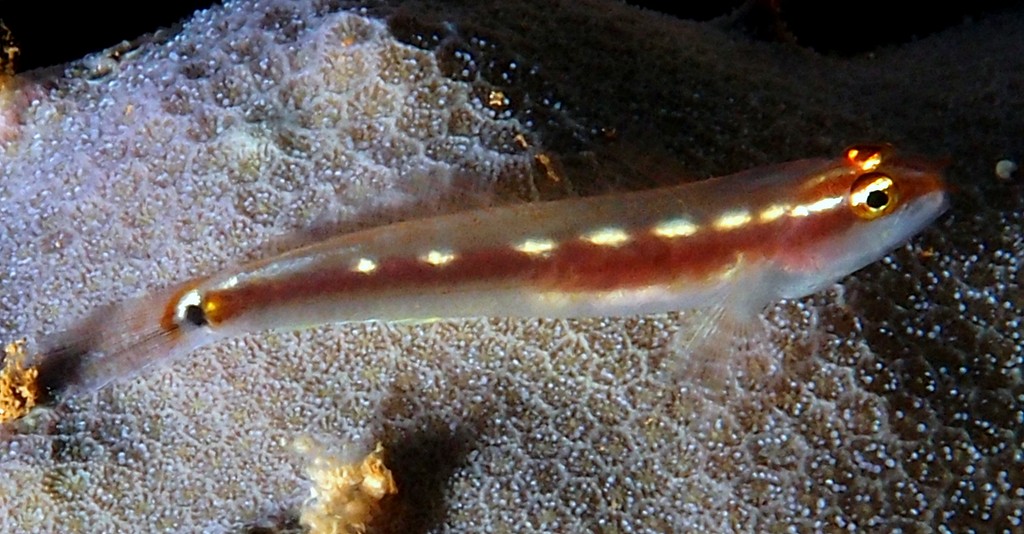EVIOTA PUNYIT - (TORNABENE, VALDEZ & ERDMANN, 2016)
Actinopterygii (Gigaclass) > Actinopteri (Class) > Teleostei (Subclass) > Gobiiformes (Order) > Gobioidei (Suborder) > Gobiidae (Family) > Gobiinae (Subfamily) > Eviota (Genus)
Gobie pygmée de Punyit, Punyit dwarfgoby,
Description
Dorsal spines (total): 6; Dorsal soft rays (total): 8-9 (usually: 9); Anal spines: 1; Anal soft rays: 7-8 (usually: 8); Pectoral fin rays: 15-17 (usually: 16), all unbranched; The length of fifth pelvic ray 50% (40–80%) that of fourth pelvic ray; fourth pelvic ray with 11-15 (usually: 12-14) primary branches; Fourth pelvic ray with 0–1 segments between consecutive branches; Pelvic fin membranes well developed; Caudal-fin rays: 16-17 branched and 11-12 segmented; Lateral scale rows: 22-24; Transverse scale rows: 6-7; Cycloid or reduced ctenoid scales on ventral surface of abdomen; First dorsal fin triangular in shape, no spines notably elongate or filamentous; Genital papilla in male smooth, long and not fimbriate, extending to the base of the first or second element of the anal fin; Female papilla smooth and bulbous with elongated projections on lateral edges of tip, with several shorter projections medially; Gill opening extending to just below pectoral fin base. Max. length: 1.8 cm SL. Depth range: 12 – 45 m.
Color
Semi-translucent body with a prominent reddish mid-lateral stripe extending from snout to caudal peduncle in life; Presence of distinctive row of white marks on upper part of red stripe with few white spots below; Caudal fin base with pale-edged black spot.
Etymology
Eviota: from Greek prefix, ev-, eu-, = good or well, very + from Greek letter, iota = smallest letter in the Greek alphabet and often figuratively used to describe anything small or insignificant. Referring to Eviota epiphanes (Jenkins, 1903), which, at 1.0-1.9 cm in length, Jenkins claimed was the “smallest vertebrate that has up to this time been described”.
punyit: named in honor of Pulau Punyit, Negara Brunei Darussalam, where this beautiful species was first recognized as being distinct from Eviota sebreei.
Original description: Eviota punyit Tornabene, Valdez & Erdmann 2016 - Type locality: Porter Patch, Brunei Darussalam, 04°53.475′N, 114°24.321′E.
Distribution
Red Sea, Indo-West Pacific: Oman, Seychelles and Comoros east to Ryukyu Islands (Japan) and eastern Indonesia, south to New Caledonia.
Biology
Found exclusively on coastal reefs with significant freshwater influx and terrigenous sedimentary input. Typically solitary or in small groups of maximally two or three individuals. Its shows a distinct preference for large foliose coral colonies.
Similar species
Eviota sebreei (Jordan & Seale, 1906) - Reported from New Caledonia - Link to the species (here).
Last update: 2, August 2022
Gobie pygmée de Punyit, Punyit dwarfgoby,
Description
Dorsal spines (total): 6; Dorsal soft rays (total): 8-9 (usually: 9); Anal spines: 1; Anal soft rays: 7-8 (usually: 8); Pectoral fin rays: 15-17 (usually: 16), all unbranched; The length of fifth pelvic ray 50% (40–80%) that of fourth pelvic ray; fourth pelvic ray with 11-15 (usually: 12-14) primary branches; Fourth pelvic ray with 0–1 segments between consecutive branches; Pelvic fin membranes well developed; Caudal-fin rays: 16-17 branched and 11-12 segmented; Lateral scale rows: 22-24; Transverse scale rows: 6-7; Cycloid or reduced ctenoid scales on ventral surface of abdomen; First dorsal fin triangular in shape, no spines notably elongate or filamentous; Genital papilla in male smooth, long and not fimbriate, extending to the base of the first or second element of the anal fin; Female papilla smooth and bulbous with elongated projections on lateral edges of tip, with several shorter projections medially; Gill opening extending to just below pectoral fin base. Max. length: 1.8 cm SL. Depth range: 12 – 45 m.
Color
Semi-translucent body with a prominent reddish mid-lateral stripe extending from snout to caudal peduncle in life; Presence of distinctive row of white marks on upper part of red stripe with few white spots below; Caudal fin base with pale-edged black spot.
Etymology
Eviota: from Greek prefix, ev-, eu-, = good or well, very + from Greek letter, iota = smallest letter in the Greek alphabet and often figuratively used to describe anything small or insignificant. Referring to Eviota epiphanes (Jenkins, 1903), which, at 1.0-1.9 cm in length, Jenkins claimed was the “smallest vertebrate that has up to this time been described”.
punyit: named in honor of Pulau Punyit, Negara Brunei Darussalam, where this beautiful species was first recognized as being distinct from Eviota sebreei.
Original description: Eviota punyit Tornabene, Valdez & Erdmann 2016 - Type locality: Porter Patch, Brunei Darussalam, 04°53.475′N, 114°24.321′E.
Distribution
Red Sea, Indo-West Pacific: Oman, Seychelles and Comoros east to Ryukyu Islands (Japan) and eastern Indonesia, south to New Caledonia.
Biology
Found exclusively on coastal reefs with significant freshwater influx and terrigenous sedimentary input. Typically solitary or in small groups of maximally two or three individuals. Its shows a distinct preference for large foliose coral colonies.
Similar species
Eviota sebreei (Jordan & Seale, 1906) - Reported from New Caledonia - Link to the species (here).
Last update: 2, August 2022
